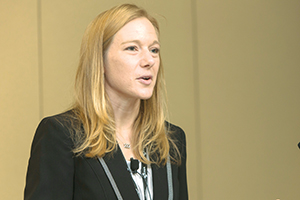By BETSY TAYLOR
ORLANDO, Fla. — Bon Secours Health System has created a system-wide approach to drive clinical transformation, drawing from a strategic plan to ensure quality and taking steps to promote consistent adherence to evidence-based practices in core clinical areas.
"A Structured Accountability from C-Suite to Bedside Produces Results" was the focus of an Innovation Forum at the Catholic Health Assembly last month. The presentation was by Dr. Marlon Priest, executive vice president, chief medical officer and market lead for senior services with Bon Secours Health System, and Anna Grant, director of integration and clinical excellence for Bon Secours Health System. Grant was recognized at the assembly with a "Tomorrow's Leaders" honor, a recognition for outstanding individuals with the potential to guide the ministry in the future.

Anna Grant
The $3.2 billion nonprofit Bon Secours Health System has facilities in six states, including 19 acute-care hospitals.
Priest and Grant focused much of their presentation on the system's work to ensure patients get the same high standard of care at every Bon Secours facility. One key way the system has done this is through the creation of a tool called the "reliable care accountability matrix," developed in fiscal year 2015 and refined in fiscal year 2016, according to Grant.
It sets core standards of practice for patient care related to employee hand washing and preventing clostridium difficile infection, catheter-associated urinary tract infections and surgical site infections. Other core areas of focus include managing length of stay, preventing avoidable readmissions and mortality reduction. The matrix also sets expectations related to patients' experience of care as measured by the Hospital Consumer Assessment of Healthcare Providers and Systems, a standard survey instrument and data collection methodology for measuring patients' perceptions of their care.
As Bon Secours Health System developed its plans related to accountability, executives listened to a lot of opinions from employees to gauge their response to the proposed core areas of focus. The system also can track shortfalls and improvements against a baseline. It has data related to all focus areas in its clinical transformation efforts. As one example, infection control practitioners at each facility report on hand hygiene and other infection prevention measures into the Centers for Disease Control and Prevention's National Healthcare Safety Network. While hand hygiene is self-reported, the system teaches standards and also has independent observer programs for tracking and improvement, Grant said.
As part of the clinical transformation work, the system asked leaders to provide a grade for how they thought their facilities were doing in each area; and, when the letter grade for performance didn't match the data, the system asked leaders to work on plans to improve in that area.
Members of a clinical excellence team make facility site visits, with each site visit including two or three people from the health system office and a clinical leader. Team members may include the associate chief nursing officer, the chief nursing informatics officer, the director of quality, the program manager for experience of care, the director for care management and the director for care coordination and outcomes, Grant explained after the presentation.
After each scheduled site visit, the clinical excellence team reviews the findings with leadership, Grant said. Clinical leadership communicates the overall findings to staff, she said.
Part of the work also has been encouraging executive leaders and administrators to become actively involved in supporting and deploying the practices the system is focused on. Local leaders round at facilities and engage in education and spot coaching related to the key areas.
After all the facility visits are completed in a year, an executive summary of findings across all hospitals is presented to the system's executive management team and its quality committee by Andrea Mazzoccoli, senior vice president chief nursing executive and quality officer, and Priest, Grant said. Through forums such as nurse manager meetings, unit meetings or huddles, information can be shared in individual facilities and across the organization.
Priest said an important part of the work has been to help employees link their day-to-day work to the mission of the health care system, "to provide good help to those in need."
He added that limiting the scope of the expectations in the accountability efforts is a help for busy employees. "Don't boil the ocean for … a cup of tea," Priest said.
Grant provided a few examples after the presentation of ways the structured accountability approach has resulted in improvements at Bon Secours Health System.
She said the clostridium difficile standardized infection ratio has decreased by 49 percent from the first quarter of the 2015 calendar year compared to the first quarter of the 2016 calendar year. To determine this ratio, Bon Secours facilities submit infection data to the CDC's National Healthcare Safety Network. Based on the CDC's national database and information on the types of units in a hospital and the level of infection risk at the facility, the network calculates an expected number of infections and its standardized infection ratio. These ratios show if a hospital is performing as national data would predict, Grant said.
She said the mortality index — which represents the ratio of observed to expected mortalities — decreased by 5.6 percent from its baseline. The system also has seen improvements in hospital ratings related to the Hospital Consumer Assessment of Healthcare Providers and Systems.
Copyright © 2016 by the Catholic Health Association
of the United States
For reprint permission, contact Betty Crosby or call (314) 253-3477.